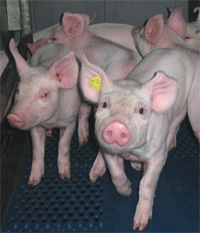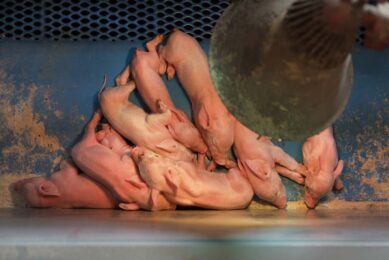Weaner diets: Prebiotics or probiotics?

The use of prebiotics and probiotics is widely being used in pig diets, as these additives have demonstrated a high efficacy preventing gut disorders and improving gut health, in particular in the period immediately post-weaning. This article elaborates on their exact functioning – and gives an example.
By Dr Marisol Castillo, Rubinum, Spain
With the European Union ban on antibiotics, much European research has been conducted into finding alternatives
to maintain high levels of nutrition in animal feed – and where possible to improve these. In this respect, alternatives in feed additives are available in the quality of probiotics and prebiotics – and both are widely being studied to discover more knowledge as to when or when not to use them.
Probiotics are defined as living micro-organisms in feed which, when taken at certain levels, provide stability of the intestinal flora (Methinkoff, 1908). Basically, three different groups of bacteria are used: lactic acid bacteria, mainly enterococci (Enterococcus faecium), lactobacilli (Lactobacills farciminis and Lactobacillus rhamnosus) and Pediococcus acidilactici; bacteria belonging to the genus bacillus (Bacillus cereus, Bacillus licheniformis and Bacillus subtilis); and Saccharomyces yeasts (Saccharomyces cerevisiae). On the other hand, prebiotics are defined as non-digestible food ingredients that beneficially affect the host by selectively stimulating the growth and/or activity of one or a limited number of bacteria in the colon. So, to be considered as a prebiotic an ingredient must be:
1. Neither hydrolysed nor absorbed in the upper part of the gastrointestinal tract;
2. A selective substrate for one or a limited number of potentially beneficial commensal bacteria in the lower gastrointestinal bacteria;
3. Able as a consequence to alter the colonic microbiota towards a more healthier composition.
Fructooligosaccharides, galactooligosaccharides, mannaoligosaccharides, inulin, lactulose and raffinose are the main prebiotics nowadays used, although, according to this definition, mannanoligosaccharides are not strictly prebiotics as their mode of action is due to the neutralisation of binding pathogens to mucus receptors and not acting as a specific substrate.
Feeding strategy
One of the most crucial phases of a pig’s life is weaning, as this phase of life is not only a change of diet, but also involves countless stress factors. Dietary components drastically change at this moment; lipids are being substituted by carbohydrates as the main source of energy and there is a marked change into the microbial environment shaping the profile of the piglet’s own microflora. Hence, for optimising animal health and avoiding gut disorders at weaning, the importance of balanced gut microbiota is extremely important.
In this respect, the decision of using prebiotics, probiotics – or when to use a combination of them to encourage symbiotic action, could be crucial. A good example in this respect can be found when studying the effect of the polysaccharide inulin, a prebiotic, on piglet diets. It seems that this fibre’s main mode of action, after having partly reached the lower gastrointestinal tract in an undigested form, is to reinforce the presence of some commensal bacteria of the piglet gut, in particular bifidobacteria. A higher concentration of butyrate has been found in weaned piglets fed with a diet containing 3% of inulin. The importance of butyrate on gut architecture recovery is well known, as this is crucial to optimise nutrient absorption. So, piglets receiving high dosages of inulin can be better prepared to digest complex nutrients from the diet. Recent research by Spanish feed additives manufacturer Rubinum, focused on the question as to why inulin seems to have a rather limited effect in diets for just-weaned piglets and what could be the effect of inulin on probiotics present in the just-weaned piglet’s gut.
Diet composition
The effect of inulin in piglet feed may sometimes be rather unpredictable – where a clear and definite outcome would be desirable with regard to a balanced growth leading towards a uniform batch of pigs. In the trial mentioned above, inulin only seemed to have an effect during the pre-starter period. Diet composition could be a key factor to explain that.
As indicated, inulin has been demonstated to beneficially stimulate lactic acid bacteria in the pig gut. These bacteria are not the most abundant in piglets, and its population also changes highly between animals, but its growth is stimulated and stabilised by the presence of dairy products in piglet feed. Only the pre-starter diet in these tests included milk whey, therefore, the inclusion of whey would help inulin reinforce the natural population of bifidobacteria and showing better performance.
In addition, the numbers of bifidobacteria already present in the piglet’s gut may also play a role to explain the unpredictable. Recent studies have identified lactobacilli as one of the main bacterial groups of young piglets, whereas the abundance of bifidobacteria is much more lower. Thus, it seems reasonable to hypothesise that only those piglets having a marked population of bifidobacteria in their gut will be stimulated in terms of health and growth by inulin. This fact would have increased differences in growth from those animals fed the probiotic group.
Probiotic
The alternative to presenting additional prebiotics to the pig population would be to add a probiotic – and this was the second element of the trial mentioned above. In the trial, Bacillus cereus var. toyoi was added, which is commercially available as Toyocerin, marketed by Rubinum.
Several studies, like e.g. Bréton in 1995, have demonstrated the effect of B. cereus var toyoi stimulating the growth of some specific beneficial bacteria in the upper gastrointestinal tract in the gut such as lactobacilli. This group of bacteria play a key role on the maturation of immune system, gut recovery from weaning and directly fighting against potential gut pathogens in the upper gastrointestinal tract such as E. coli, the main agent of colibacilosis, a pathogenic process that starts in duodenum three to ten days after weaning. The trial was carried out at CEP (Centro Experimental de Porcino; Pigchamp Pro Europa), a 550 sow farm, placed at Aguilafuente, Segovia, Spain. For the trial, 288 piglets were used.
With a diet based on a prebiotic, the abovementioned probiotic or a control diet – the effects could be noted on:
• Bodyweight homogeneity: Inuline increased BW dispersion at the end of the pre-starter phase (experimental day 14) and B. cereus var toyoi decreased it at the end of the experimental period. See Figure 1.
• Mortality: Although the percentage of mortality was higher than normal in the facilities used (3.8% vs 2.5%), results showed a lower percentage of deaths due to digestive pathology on piglets from the probiotic group compared with the control ones (2.5 vs 6.4%; P<0.05). See Figure 2.
• Faeces consistency: This was normal during the experimental period. Only there was some faeces inconsistency at the end of the pre-starter phase (experimental day 14) which was in this case the animals fed with the probiotic – the ones that tended to show a lower percentage of pens having faeces consistency affected (value > 0). This fact might be related to the direct effect of B. cereus var toyoi against E. coli as it has been demonstrated that an inhibition of this bacteria prevents and decreases the severity of diarrhoea that appears during the initial days after weaning.
The effect of pro- and prebiotics on piglet diets depends highly on the typical diet composition for pre-starter and starter diets. The effect of a fibre as a source of food for bacteria would be interesting during first diets; the effect of probiotics can be considered constant and is thus suitable for both
diets. PP
diets. PP
*References available on request
*********CLICK HERE FOR THE PDF VERSION OF THIS ARTICLE
Source: Pig Progress magazine Volume 26.1
Join 18,000+ subscribers
Subscribe to our newsletter to stay updated about all the need-to-know content in the pigsector, three times a week. Beheer
Beheer










 WP Admin
WP Admin  Bewerk bericht
Bewerk bericht